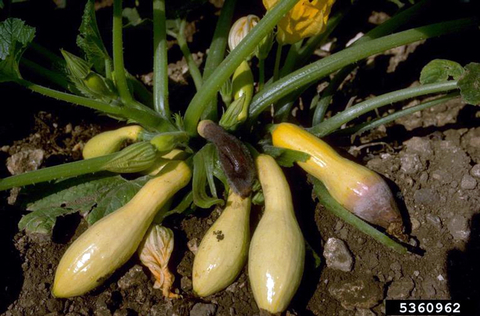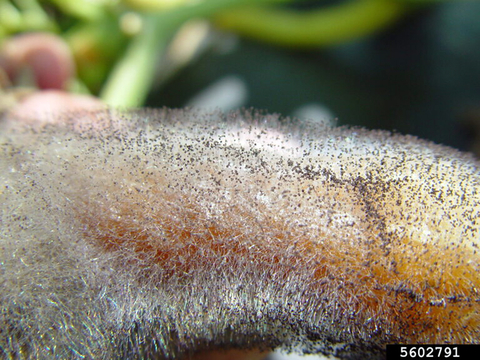Quick facts
- Choanephora rot, also known as wet rot, is a disease most commonly found on summer squash under wet conditions. This disease also infects other cucurbits including pumpkins and zucchini.
- The fungus can infect flowers or fruit during prolonged wet periods.
- Infected fruit are mushy, brown, and covered in fuzzy black growth.
- The fungus survives from season to season in crop debris and moves to new flowers by insects, splashing water or wind.
- Because this pathogen tends to infect individual fruit, remove infected fruit immediately to prevent it from spreading to the rest of the plant.
How to tell choanephora rot from other vining vegetable issues
-
White, then purplish-black fungal growth, covers the flowers.
-
The blossom end of the squash is soft, rotted and covered with fluffy purplish-black fungal growth.
Biology
- The fungus Choanephora cucurbitarum causes choanephora rot.
- The fungus survives from season to season in crop debris and moves to new flowers by insects, splashing water or wind.
- Infection most commonly occurs on flowers, although the fungi can also infect through wounds on the fruit.
- Infected flowers are soft, rotten and quickly covered with first white, then purplish-black fungal growth. In female flowers, the infection progresses into the fruit and results in soft water rot of the blossom end of the squash.
- The fungus thrives in wet conditions.
Managing choanephora rot in the garden
Rotting of small summer squash fruit is often a result of poor pollination, especially for the first round of fruit the plant sets.
- Space plants far enough apart to provide enough air movement in the field to quickly dry flowers and fruit.
- Remove infected fruit immediately to prevent it from spreading to other fruit.
- Proper spacing at planting is important, a guide for proper spacing can be found in the UMN vining vegetable growing guide.
Managing choanephora on farms
- Rotate vegetables so two or more years pass before planting any member of the squash family in the same location.
- Use drip irrigation instead of overhead sprinklers if possible.
- Space plants to provide enough air movement in the field to quickly dry flowers and fruit.
- Raised plant beds and plastic or paper mulch may limit fruit contact with moist soil and reduce moisture in the lower plant canopy.
- Remove infected fruit immediately to prevent it from spreading to other fruit.
- Fungicides are ineffective against choanephora rot because new susceptible flowers open every day.
Reviewed in 2022



